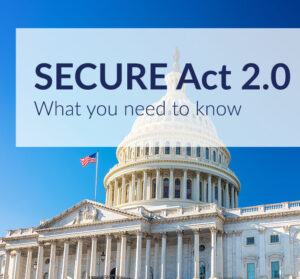New as of 2023, the SECURE Act 2.0 includes changes that may affect your retirement saving and charitable giving. These changes may make it even easier for you to impact your favorite charitable organizations, such as the Catholic United Financial Foundation. Below are three important things to know about the SECURE Act 2.0.

The first big change comes to RMDs. The original SECURE Act pushed RMDs from age 70 1/2 to age 72. The SECURE Act 2.0 changes the RMD rule even further. The new rule immediately pushes RMDs out to age 73, and if you were born in 1960 or later, it makes your RMDs start at age 75.
If you were already 72 or older in 2022, then that means you fell under the older rule and had your first RMD, or possibly have already been taking RMDs because you started under 70 1/2 before the SECURE Act was even a law.
• Born 1950: RMD age is 72, or 70 1/2 if taking it prior to the original SECURE Act
• Born 1951 – 1959: RMD age is 73
• Born 1960 or later: RMD age is 75
This change gives you more time to save (or, in a wobbly economy, for your stocks to recover). You will enjoy additional tax-free growth.
Since 2006, individuals who are required to take annual minimum distributions from their IRA accounts have had the option of transferring up to $100,000 per year directly from one or more IRAs to one or more public charities and/or private operating foundations such as the Catholic United Financial Foundation. This transfer to a public charity is known as a “qualified charitable distribution” (QCD).
SECURE Act 2.0 indexes the $100,000 annual exclusion limit for inflation beginning in 2024 and provides a second option to take advantage of the exclusion beginning in 2023 for those taxpayers who have reached age 70 1/2 and are required to take minimum distributions.
Continued below.
If you want to learn more about giving opportunities created by the SECURE Act 2.0, watch our webinar, The Big Give, available now.
SECURE Act 2.0 permits a taxpayer who is 70 ½ or older to make a one-time $50,000 distribution directly from an IRA or IRAs to a charitable remainder trust or a charitable annuity and make a one-time election to treat the contributions as if they were qualified charitable distributions made directly to a charitable entity.
Unlike a direct charitable contribution, contributions to a split-interest entity benefit not only the charity but also the individual IRA owner. The overall economic impact is that at least a small portion of what is transferred goes to charity and up to 90 percent of the economic value of what is transferred (up to approximately $45,000) can be paid out to the individual IRA owner over a selected term of years, not exceeding 20 years, or for his or her lifetime.
Note: This opportunity comes with special rules, so contact us to see if this option is right for you.
We can help answer any additional questions you might have about how the new retirement laws affect your charitable giving. Contact Robert Heuermann at 651-765-4135 or foundation@catholicunited.org to have a conversation about your legacy.
Catholic United Financial Foundation does not provide legal or tax advice. The information herein is general and educational in nature and should not be considered legal or tax advice. Tax laws and regulations are complex and subject to change, which can materially impact investment results. Catholic United Financial Foundation cannot guarantee that the information herein is accurate, complete, or timely. Catholic United Financial Foundation makes no warranties with regard to such information or results obtained by its use, and disclaims any liability arising out of your use of, or any tax position taken in reliance on, such information. Consult an attorney or tax professional regarding your specific situation.